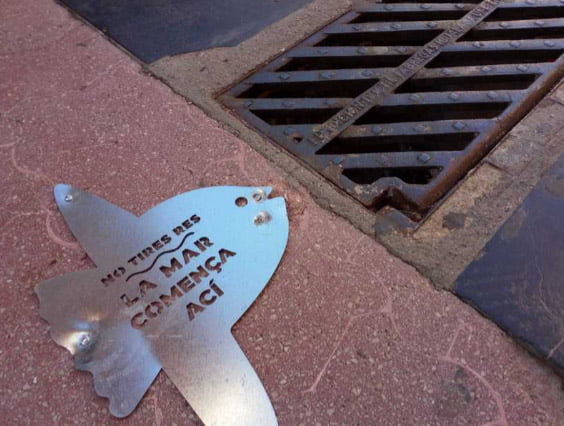Last year, the UN declared the "decade of the oceans" (2021-2030) in response to the necessary protection and study of our seas. The set of activities is coordinated by the UNESCO International Oceanographic Commission. During this decade, governments and administrations as well as associations, companies and the population in general are urged to promote, support and participate in the challenges posed by science in relation to the sea. One of these challenges is undoubtedly the emerging contamination by microplastics, which are already present in all the seas and which, unfortunately, are also found in many marine organisms, including many of the species that we eat.
From the Montgó-Dénia-UA Scientific Station and in collaboration with the Oceanogràfic de València, different studies are being carried out on the microplastics present both in coastal waters and in different organisms. Microplastics are defined as those pieces of any type of plastic material less than 5mm, whether they are fibers or sheets.
The first results of microplastics present in the sea carried out in the coastal sea between Valencia and the coast of the Marina Alta showed that the fibers were 75% of all of them, mainly of textile origin (clothing and industrial) or from remains of ropes. The remaining 25% corresponded to micro pieces, whose origin is the degradation of plastic film (such as bags and containers). After analyzing more than 150 samplings carried out with plankton nets (with a mesh size of 0,2 mm), the results offered densities between 1 and 120 pieces per
10m 3 of water and a fairly patchy distribution.
These figures indicate that something will have to be done. It is clear that we must not throw plastics into the sea, neither directly nor indirectly. If there are plastics in a ravine, or in the street, they will go out to the sea when it rains, as has been rightly announced in some scuppers of municipalities in the Marina Alta.
Rainwater scuppers can drag plastics of all kinds that will end up sooner or later in the sea, where they will fragment to form microplastics, thus making it easier for them to enter the animals of the marine food chain and, finally, our bodies. .
But where do the fibers come from? Mainly from washing machines when it comes to clothes made with polyester and other plastics that sewage treatment plants are not capable of eliminating. Why not incorporate filters at the outlet of washing machines? This would be a cheap and effective solution to eliminate a large part of these fibers that will end up in the sea. In addition, we would prevent them from accumulating in the treated water or in the sludge from the treatment plants and, if it is later irrigated, in the agricultural soil, where different organisms can ingest it and pass it to the food chain of terrestrial animals. Forcing the installation of one of these filters in all washing machines would hardly cost a few euros and would help solve a major environmental and health problem.
First studies of microplastics and marine animals
The first group of marine animals in which the effect of microplastics has been studied in this collaboration between the Montgó-Dénia-UA Scientific Station and the Oceanogràfic is jellyfish. Despite having a certain bad reputation among swimmers for being stingers, they are extremely important animals in marine ecosystems. In addition to serving as food for other species (turtles, tuna, swordfish, sunfish, bonito, etc.) they also serve as a refuge for the fry stages of some of them (bogas, horse mackerel and amberjack among others) and help control excesses of other species (plankton or juvenile stages of larger species). When they die, their remains sink to the bottom of the sea and, in this way, they participate in the transfer of food from the water column to the sea floor, and down there there are many species of commercial interest, from fish to crustaceans.
The results of these studies, which will be disseminated at international conferences and published in scientific journals, show that although jellyfish are not capable of accumulating plastics indefinitely, they do retain them for a time in their body, which would facilitate this transfer of the plastics that are in the water column, towards the sea floor once they die. In addition, jellyfish in the natural environment are also
has found that a large majority (78%!) of them contain microplastics.
These studies on microplastics will serve as the basis for drawing up a series of proposals to achieve a reduction in plastics in the sea, which will be sent to the different decision-making centers (both national and international), since each one has specific competencies and ability to act. The involvement and commitment of both the town halls and the regional, national and European Union governments or the European Union will be sought.
UN through its Decade of the Oceans program.
The Montgó-Dénia-UA Scientific Station is consolidated as a first-class marine and environmental research center
The Montgó-Dénia-UA Scientific Station has been carrying out scientific studies of an environmental nature and activities for training and disseminating science for more than five years. In this trajectory his works, the majority carried out in the Marina Alta, have already been published in the best scientific journals and he collaborates constantly with other Spanish universities and other countries. It also collaborates in programs on the environment and natural resources of international organizations such as the European Commission, the World Trade Organization or the UN.
The Scientific Station arose from the initiative between different public entities such as the University of Alicante, the Dénia City Council, the Autonomous Organism for National Parks and the Ministry of Agriculture, Rural Development, Climate Emergency and Ecological Transition. And it is part of the UA strategy to bring research closer to the territory (https://web.ua.es/es/sedes-aulas-y-estaciones.html) to help solve the many environmental and natural resource challenges which we have to face.








Let's see if Dénia finally stands out for something other than destroying the territory.